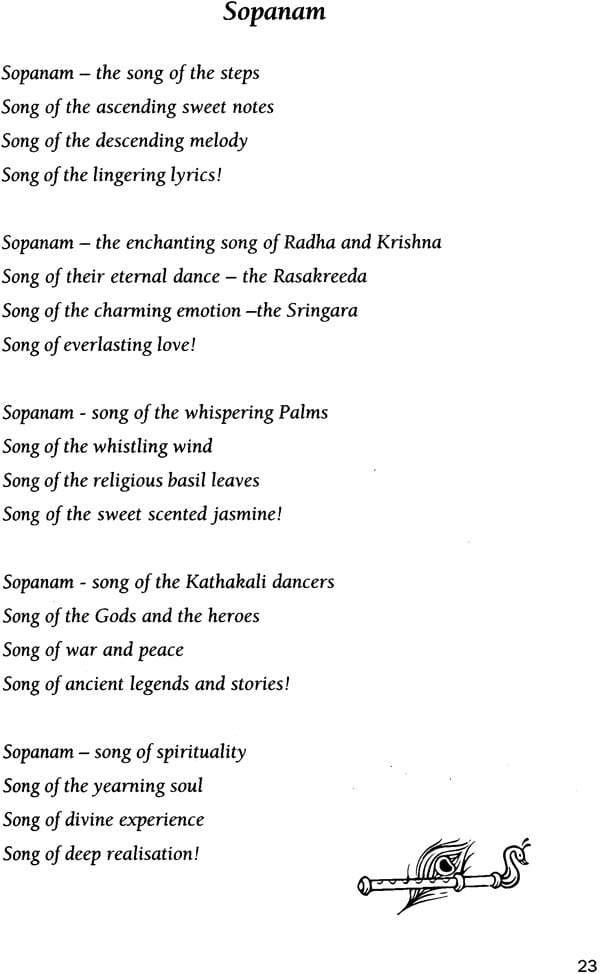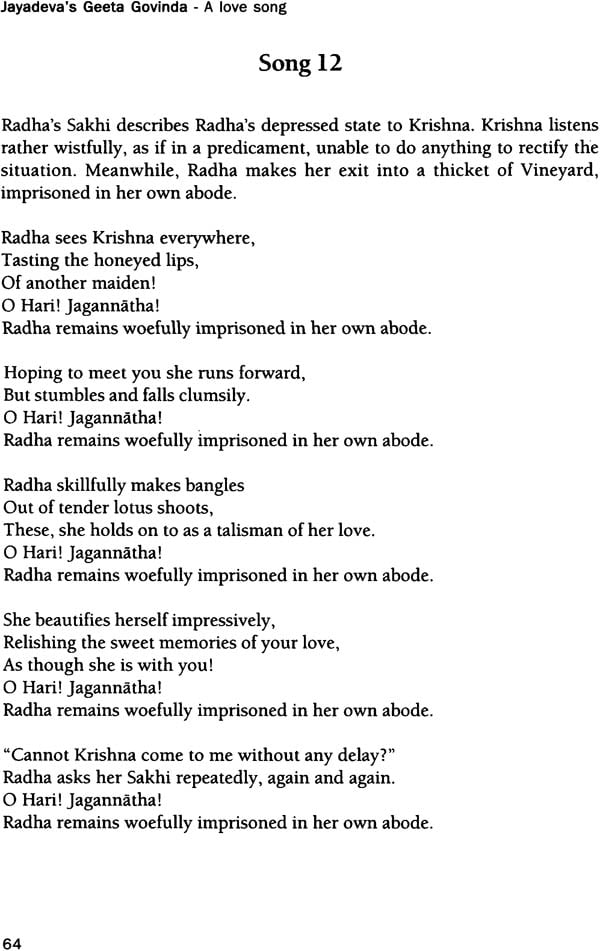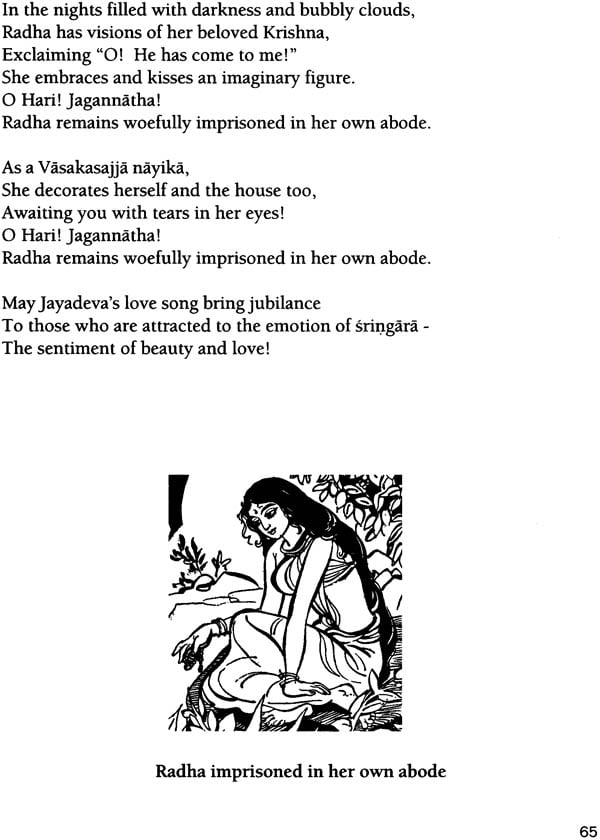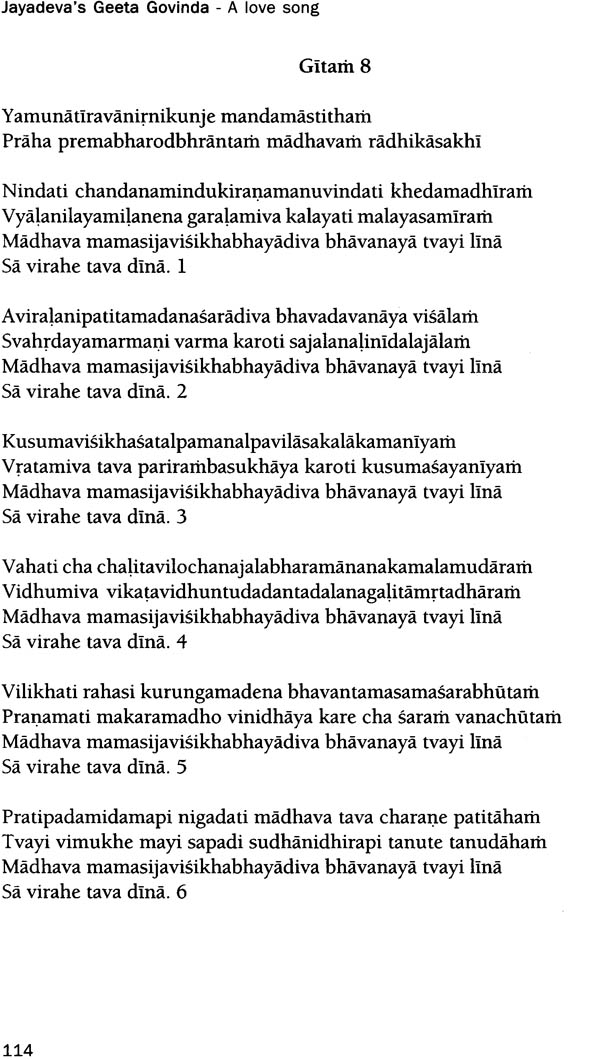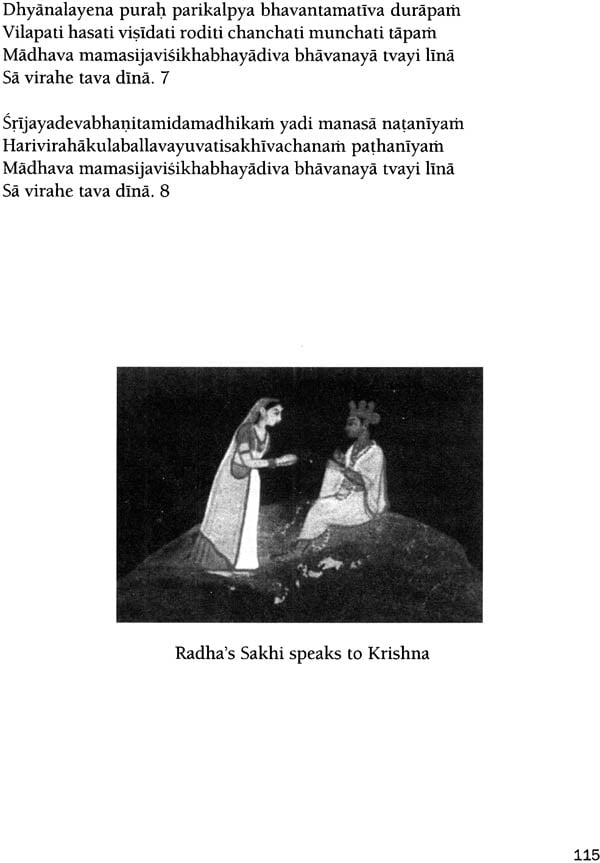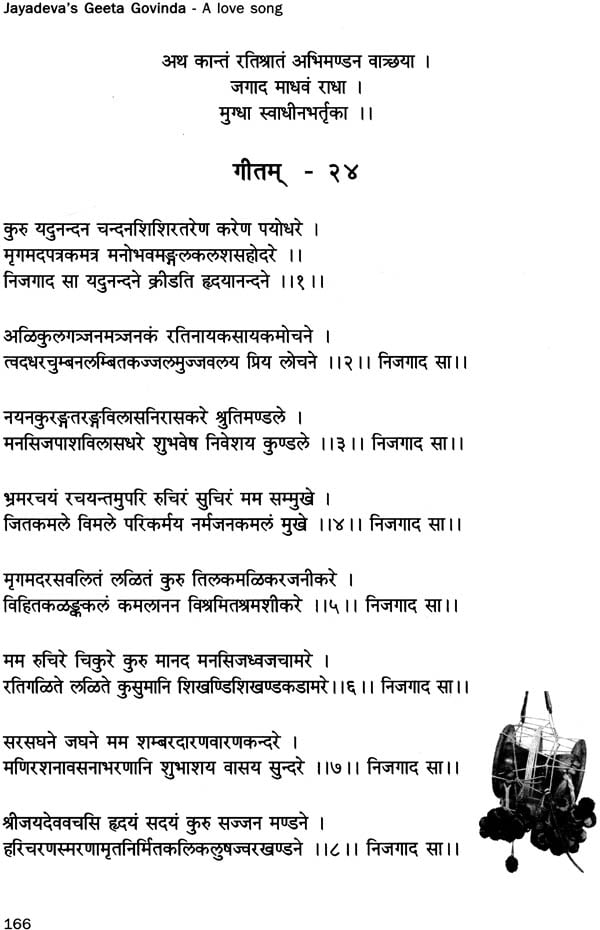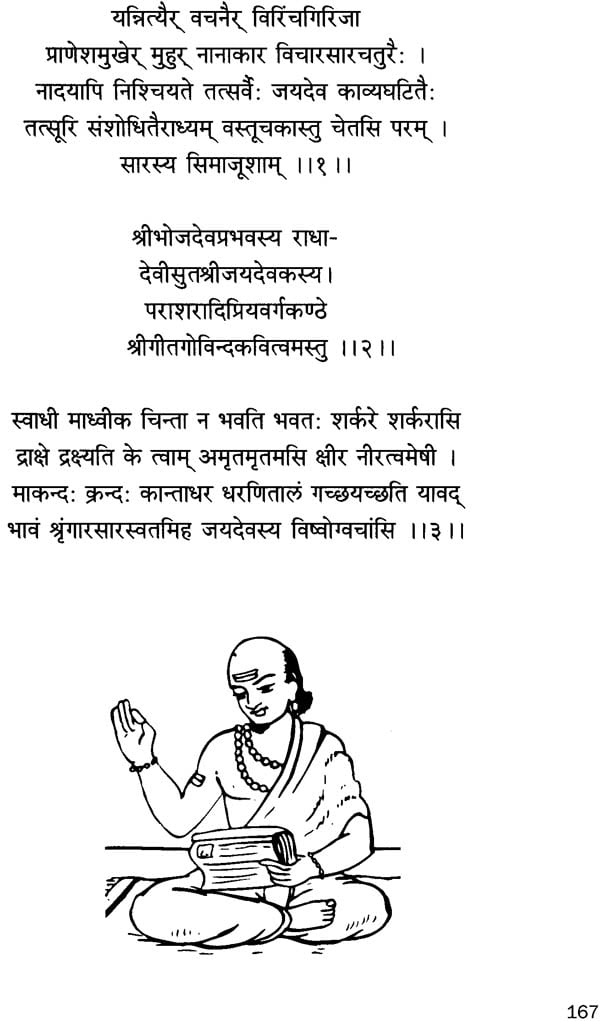
Jayadeva's Geeta Govinda (A Love Song)
Book Specification
| Item Code: | NAM451 |
| Author: | Geeta Radhakrishna |
| Publisher: | Radha Krishna Menon, Mumbai |
| Language: | Sanskrit and English |
| Edition: | 2010 |
| Pages: | 168 (Throughout B/W Illustrations) |
| Cover: | Paperback |
| Other Details | 9.5 inch X 7.0 inch |
| Weight | 320 gm |
Book Description
"Geeta Radhakrishna's deep love for this form of soulful Music has prompted her to demystify this rich musical heritage of Kerala. Her translation of the Ashtapadis has done full justice to the lilting poetic beauty of Jayadeva. The choice of word and phrasing is highly aesthetic and brings out the spiritual love of Radha and Krishna without reducing it into a mundane translation of passion and eroticism. The bhava or emotional content is thus very carefully portrayed. Geeta's book is an invaluable asset to the dance fraternity."
Jyothi Mohan in "Shanmukha"
"Geeta Radhakrishna's love of Geeta Govindam, which is natural to a dance and devotion to Sri Krishna are evident in her work. She offers it as an altar flower at his shine."
V. Sivaramakrishnan "Dilip"
"Geeta Radhakrishna herself a gifted dance of Mohiniattam, a dance form celebrating love or sringara rasa, and she has been successful in sublimating sringara into Bhakti rasa. Thus, she is the most competent person to evoke the spirit of Geeta Govinda, through her translation which effectively recreates the lyrical and poetic beauty of it.
Prof. Dr. Annakutty Findeis
In the present age of technology and globalisation, one often speaks of fusion of cultures, cultural pluralism, melting pot of cultures etc, to suggest the human aspiration for living together without much clash of cultures in the world of plurality and diversity. India itself is a world full of varieties: geographical, linguistic, cultural religious and otherwise, Yet there had been much of cultural interaction throughout the centuries. These cultural interactions within India itself need to be studied and understood, if we wish to appreciate out cultural heritage in all its width depth. Geeta Radhakrishna's present book "Jayadeva's Geeta Govinda – the love song", I consider as one such attempt. The work itself suggests to us a bond of love and understanding between North and South of India, a loving encounter between Sopanam music and a lyrical Geeta Govinda, a litrary product in Sanskrit by Jayadeva.
We are mostly aware of only major styles of Indian music – Hindustani and Kernatik-forms of music Dhrupad and Sopanam are liss known. Sopanam is a melodious music originated from the tiny kavus of Kerala. Geeta Radhakrishna informs us of Sopanam music in brief, in section one of her book. I would like to stress on one or two aspects of the Sopanam music in view of Geeta Govinda.
Sopanam is a divine music, temple music, sung before a deity by a special devotee, who is also part parcel of the temple. The word Sopanam itself means music sung at the footsteps leading to the innermost chamber or sanctum sanctorum of the temple, called Sri Kovil. I thus symbolises the gradual ascent and the spiritual evolution or transformation of the soul, longing for the loving union with God. With this slow and gradual process of transformation, in other words, with the symbolism of steps (staircase = Sopanam) suggesting the spiritual growth or ascent, Sopanam music becomes very suitable for the musical rendering of Geeta Govinda, the divine song of Jayadeva. Geeta Govinda depicts the longing, the agony and the pangs of love in its various moods. We see in Geeta Govinda, too, a gradual spiritual development. A shift from separation love in union! The human body with all its emotions and sensuousness acquires importance in the poem. Human body itself is the temple of God. Thus, to render in songs the longing of this body for the divine, the temple music Sopanam is most worthy. And probady, that is why it was sung in Sopanam style.
Originally, Sopanam music was associated with Siva temples and Devi temples. But it came to be associated with Vishnu and Krishna temples in the wake of Vaishnavism in Kerala, when songs of Geeta Govinda or Ashtapadi became part of the rituals. Thus, we see cultural interaction and assimilation happening.
The lyrical work Geeta Govinda is a medieval text belonging to 12th century, which became very popular is the following centuries and till date gaining a pan Indian resonance. Jayadeva the author of Geeta Govinda is known as a poet-saint in Indian tradition. This name is the poet's singnature in Geeta Govinda and also it becomes an epithet of Krishna in the second song (Jaya Jaya Deva Hare). It is still being debated as to whether he belonged to Bengal or Orissa. Yet, many consider Bengal to be his homeland.
The poem Geeta Govinda is, as we all know, dedicated God Krishna. It is a celebration of Krishna's love for Radha and also Rasha's ove for Krishna, set in the context of spring. Love in all its moods of longing, pain anguish and pleasure are presented, specially evoking rasas of vipralambha Sringara (love in separation) and sambhoga Sringara (love in union). Through the setting i.e. the environment of springtime, nature too is made part of this intense, passionate drama of human and love, of the cosmic play of love. To experience the erotic mood in the two above mentioned moods, is traditionally considered to be the height of aesthetic joy, Eadha and Krishna are Vehicles (vibhava) for the universalisation of erotic emotion. Jayadeva mingles the aesthetic experience (here the erotic) and the religious mysticism. This erotic play is not meant for itself. I t has to be seen in the context of the Bhakti cult. He integrates also elements of older folk religious traditions like Tantra.
In twelve parts, the poet sings the love-relationship between Krishna and Rasha – Whereby the separation and the reunion towards the end, form the central theme.
The spread of Geeta Govinda into different parts of India and Nepal and its unique impact on the literary and artistic traditions of India are worth researching. Through the spread of Bhakti movement, Geeta Govinda found its way into various regional languages and art forms. Geeta Govinda could be thus understood from different levels of consciousness through word, art, music and dance. The various translation, adaptations and imitations of Geeta Govinda are evidences of its vast popularity in the Indian context through centuries. It enriched immensely the cultural life and religious spirituality of India. It may be worthwhile to study the intercultural aspects of the various forms of reception and its impact on the regional literatures and cultures in India.
The post Jayadeva reception of Geeta Govinda, i.e. from 14th to 17th or 18th centuries, shows main developments in the theological interpretations and corresponding cults. In South, Geeta Govinda attracted all levels of society and a particular religion known as Radha-Kalyanam, give importance to Radha. Thus, Radha of the literary tradition became divinised. Another Geeta Govinda reception in Assam focused, on the contrary, on Krishna cult. In the 17th and 18th centuries Geeta Govinda became part of the rituals in the Guruvayur temples in Kerala. Here too, Krishna cult dominated to the excusion of Radha. A third form of cult developed in Vrindavan, where the 'yugala' or 'jugalarupa' is created, i.e where Krishna and Radha are inseparably united.
The influence of Geeta Govinda was not limited only to India. In the years of the encounter between India and Europe or the West, we see that Geeta Govinda fascinated scholars, ports and Europe or the West, we see that Geeta Govinda fascinated scholars, poets and mystics. The British Indologist William Jones was the first to carry Geeta Govinda across oceans. His English translation (Calcutta 1792, reprinted in London 1799) became the source for the continental European reception. The German poet Wolfgang von Goethe was impressed by Geeta Govinda, which he read in the German translation, by f.H. van Dalberg (1802). The German romantic poet Friedrich Rueckert (1829) undertook a poetic translation in verse form. A Sanskrit edition combined with a Latin translation was published by Christian Lassen in Bonn, Germany (1836), which evoked the interest of German Indologists.
Since then, many other translations into other European languages and several critical editions of the Sanskrit text of Geeta Govinda followed, which spread the fame of this unique poem of human and divine love in the world. An example of indological research on Geeta Govinda is the English translation and critical study of it by the Americam Indologist Barabara Stoler Miller (1977).
The present English translation of Geeta Govinda, rendered by Geeta Radhakrishna, enables us to relish its Ashtapadi version in the light of the Sopanam music style. I consider this as a very valuable contribution in preserving the precious heritage of Jayadeva, presented to Kerala.
Geeta Radhakrishna herself is a gifted Dancer of Mohiniattam, a dance form celebrating erotic love or Sringara rasa, and she has been succeful in sublimating Sringara into Bhakti rasa. Thus, she is the most competent person to evoke the spirit of Geeta Govinda, through her translation, which effectively recreates the lyrical and poetic beauty of it. Geeta could dive into the depth of Geeta Govinda, where Sringara becomes transparent for Bhakti. Geeta places this widely wandered (from south to north and east to west of India) enchanting song of love at Krishna's feet for his abundant blessings. May the listening (reading) of this song of human and divine love lead us "home" from the bewildering dark nights of our times.
When my dearest mother made her transition from this world on 25th March 2002, I was heart broken. That very night, I conceived this idea of translating jayadeva's Geeta Govinda and I took it upon myself to offer it to the world, as a memorial to my mother.
My mother was very fond of music. Any kind of music brought a glow on her face and a twinkle in her eyes. However, she was particularly fond of South Indian music. The last one year of her life, she kept listening to Jayadeva's Ashtapadis. That's one reason that motivated me to translate this beautiful love song into English.
Believe it or not, I have not completed any of my writing, as fast as I have done, for the translation of Jayadeva's "Geeta Govinda". The whole translation of "Geeta Govinda", from the first song to the twenty-fourth song, took me exactly two months. It was as if I was possessed. Day and night I kept reading the Geeta Govinda and tried translating it into English without losing its essence. And, by Lord Sri Krishna's grace, I was able to publish the book during August, the same year. So, the whole process of a book took only few months. I attribute this, purely, to the blessings of my mother. It would not have happened, if her spirit had not guided and persuaded me.
My father too loved music, but he was a quiet listener. My mother, on the contrary, loved singing and always sang loudly, even while she cooked for the family. The last two years of her life, she could not sing due to her ill health, but listened to a lot of music, specially, jayadeva's Ashtapadis with great joy. I was, indeed very lucky to have sung these songs for my mother. Each day, I sang a song for her. Sometimes, I would sing many songs at a time. She listened to them with great concentration. The last six months of her life, these Ashtapadis became a compulsory item of her life. It was like a sleeping pill, without the song, she would not go to sleep. If by any preoccupation, I missed singing for her on a particular evening, she would remain awake the whole night. And the next day would be very tiresome and taxing for her. I realised that music healed her. It made her forget all her aches and pains. Though the doctor had given her only two months to live, she survived for more than two years. This is the miraculous story of my mother and the magical music of Jayadeva's Geeta Govinda.
My earlier books took a long time for completion, and, I often doubted, whether they would see daylight. "Mohiniattam Adavus" my first book, got published fifteen years after its conception, while my second book, "Mohiniattam-the dance of the enchantress" was published six years later. This is my third book and I am, indeed, happy that it has come out rather quickly. The only sad part is that my parents are no more bodily present to see it or read it. But I am sure, from somewhere above their spirits will keep a close watch on me and guide me in my work. And in subtle and miraculous ways, lead me through to a path of higher knowledge.
A.L.Basham in his "The wonder that was India" writes about spirits and quotes a passage from the Upanishads. Here, the spirit is described as a Personal God rather than as a cosmic essence.
"He encircles all things, radiant and bodyless
Unharmed and untouched by evil,
All- seeing, all- wise, all-present, self- existent,
He has made all things well for ever and ever."
In the first edition of this book published in 2002, I had fully occupied myself with the translation of the Sanskrit verses of Geeta Govinda into English. My entire focus was on how best I could translate into not just lyrical language but poetic and musical verses. And since the book was dedicated to my mother, I was in a hurry to see it printed, the same year, as her transition from this life.
In 2006, I brought out the second edition with few changes made in it. I scrutinised the Sanskrit version to the best of my ability, to make it the most authentic. The tenth Ashtapadi had only five verses in many of the earlier translator's books and so was it, in my first edition of the book too. I am happy to have searched out the three missing verses in them. So the tenth song of Jayadeva, now had the full eight verses of the original version of Geeta Govinda. Extreme care was taken to ascertain the proper spelling and authenticity of the Sanskrit verses as given in the original Sanskrit version.
I am not a Sanskrit scholar nor do I possess any degree in Sanskrit. But, I love the language and have a natural flair for it. In school, I had Sanskrit as a subject, and I remember studying the verses of Bhartrihari and Bhagavad Geeta. Often, I participated in the Sanskrit recitation competition and won prizes too. In college, I never had the opportunity to study Sanskrit. However, Sanskrit remained my first love, among the Indian languages. And whole of my life, I have been working with Sanskrit texts, be it for my work as a danseuse or singer or for that matter purely to gain knowledge of the rich Indian heritage as left behind for us, by the ancient seers and poets. Sanskrit is also very close to my mother tongue - Malayalam, which made it easier for me to grasp the language.
Malayalam is a highly evolved language, wherein most words are Sanskrit itself. As a child, when I heard my grandfather speak, I never could make out whether he spoke Sanskrit or Malayalam. He had great style in speech and never spoke the colloquial tongue. Sanskrit flourished in Kerala. There was a period in Kerala, when a mixture of Sanskrit and Malayalam was spoken and widely utilised by writers and poets as well, called Manipravalam.
It will not be out of place to mention here that Kudiattam of Kerala, the oldest dance drama of India, has three languages woven into its recital and presentation. They are Prakrit, Sanskrit and Malayalam. Prakrit is the ancient version of Sanskrit language. These dance dramas still retain the original version of all the three languages, and are performed with authenticity.
In Kerala, the people are very romantic, and enjoy love songs and love poetry. They worship Goddess Bhagavati, Sri Guruvayurappan (Krishna), Sri Ayyappan and many other Gods and Goddesses. But the most fascinating is the worship of Kamadeva - the God of love or the Cupid. There are several Malayalam songs in praise of Kamadeva or Manmatha as he is also called. He induces desire in women by shooting flowery arrows. There are five exotic flowers, the touch of which causes passion. The love plays of Kamadeva are extolled by poets in beautiful Malayalam verses. During festivals, women sing and dance standing in circles. So, it was no wonder, whenjayadeva's "Geeta Govinda" made its entry into Kerala, it was welcomed with open arms. People loved the language and the lyrics of the poetry, and when the same was sung with a melodious Raga, it made a tremendous impact. To such an extent, that most of the learned households in Kerala who had the eagerness to learn and acquire knowledge had the verses of Geeta Govinda at the tips of their fingers. But they coined another name for Geeta Govinda. They called it "Ashtapadi". 'Ash ta' means eight while 'Pada' means a verse. Ashtapadi literally means eight verses. Though an Ashtapadi had eight verses, yet it was known as one song. So in all, jayadeva's Geeta Govinda had 24 Ashtapadis - meaning 24 songs.
| Section 1 | ||
| 1 | Foreword-Prof. Dr. Annakutty Findeis | 13 |
| 2 | Preface | 18 |
| 3 | Sopanam - a poem | 23 |
| 4 | Sopanam Sangeetam - Kerala's Divine Music | 24 |
| 5 | Jayadeva's Ashtapadis in Kerala | 27 |
| 6 | Jayadeva A life sketck | 29 |
| 7 | Jayadeva and Padmavathy - a poem | 32 |
| 8 | Geeta Govinda - An introduction | 34 |
| Section 2 | Jayadeva's Geeta Govinda - Translation in English from Sankrit | |
| 9 | Prologue | 38 |
| 10 | Song 1 | 39 |
| 11 | Song 2 | 42 |
| 12 | Song 3 | 46 |
| 13 | Song 4 | 48 |
| 14 | Song 5 | 50 |
| 15 | song 6 | 52 |
| 16 | Song 7 | 54 |
| 17 | Song 8 | 56 |
| 18 | Song 9 | 58 |
| 19 | Song 10 | 60 |
| 20 | Song 11 | 62 |
| 21 | Song 12 | 64 |
| 22 | Song 13 | 66 |
| 23 | Song 14 | 68 |
| 24 | Song 15 | 72 |
| 25 | Song 16 | 74 |
| 26 | Song 17 | 76 |
| 27 | Song 18 | 78 |
| 28 | Song 19 | 82 |
| 29 | Song 20 | 84 |
| 30 | Song 21 | 86 |
| 31 | Song 22 | 88 |
| 32 | Song 22 | 90 |
| 33 | Song 24 | 91 |
| 34 | Epilogue | 94 |
| Section 3 | Jayadeva's Geeta Govinda - Transliteration in English | |
| 35 | Key to pronunciation - Diacritical marks | 98 |
| 36 | Gitam 1 | 102 |
| 37 | Gitam 2 | 104 |
| 38 | Gitam 3 | 106 |
| 39 | Gitam 4 | 108 |
| 40 | Gitam 5 | 109 |
| 41 | Gitam 6 | 110 |
| 42 | Gitam 7 | 112 |
| 43 | Gitam 8 | 114 |
| 44 | Gitam 9 | 116 |
| 45 | Gitam 10 | 117 |
| 46 | Gitam 11 | 118 |
| 47 | Gitam 12 | 119 |
| 48 | Gitam 13 | 120 |
| 49 | Gitam 14 | 121 |
| 50 | Gitam 15 | 122 |
| 51 | Gitam 16 | 123 |
| 52 | Gitam 17 | 124 |
| 53 | Gitam 18 | 126 |
| 54 | Gitam 19 | 130 |
| 55 | Gitam 20 | 132 |
| 56 | Gitam 21 | 133 |
| 57 | Gitam 22 | 134 |
| 58 | Gitam 23 | 136 |
| 59 | Gitam 24 | 137 |
| Section 4 | Jayadeva's original work in Sanskrit | |
| 60 | Jayadeva Kavirachitam Geeta Govinda | |
| 61 | Gitam 1 | 142 |
| 62 | Gitam 2 | 143 |
| 63 | Gitam 3 | 144 |
| 64 | Gitam 4 | 145 |
| 65 | Gitam 5 | 147 |
| 66 | Gitam 6 | 148 |
| 67 | Gitam 7 | 149 |
| 68 | Gitam 8 | 150 |
| 69 | Gitam 9 | 151 |
| 70 | Gitam 10 | 152 |
| 71 | Gitam 11 | 153 |
| 72 | Gitam 12 | 154 |
| 73 | Gitam 13 | 155 |
| 74 | Gitam 14 | 156 |
| 75 | Gitam 15 | 157 |
| 76 | Gitam 16 | 158 |
| 77 | Gitam 17 | 159 |
| 78 | Gitam 18 | 160 |
| 79 | Gitam 19 | 161 |
| 80 | Gitam 20 | 162 |
| 81 | Gitam 21 | 163 |
| 82 | Gitam 22 | 164 |
| 83 | Gitam 23 | 165 |
| 84 | Gitam 24 | 166 |
| 85 | Books Published by the Author |
